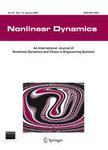版权所有:内蒙古大学图书馆 技术提供:维普资讯• 智图
内蒙古自治区呼和浩特市赛罕区大学西街235号 邮编: 010021

作者机构:Henan Univ Sci & Technol Sch Civil Engn & Architecture Luoyang 471023 Henan Peoples R China Engn Technol Res Ctr Safety & Protect Bldg Henan Luoyang 471023 Henan Peoples R China Hunan Univ Sch Civil Engn Changsha 410082 Hunan Peoples R China
出 版 物:《NONLINEAR DYNAMICS》 (Nonlinear Dyn)
年 卷 期:2025年第113卷第2期
页 面:1007-1024页
核心收录:
学科分类:08[工学] 0802[工学-机械工程] 0801[工学-力学(可授工学、理学学位)]
基 金:National Natural Science Foundation of China Key R&D and Promotion Special Project in Henan Province Science and Technology Research (joint fund) Project Natural Science Foundation of Changsha [KQ2202133] Natural Science Foundation of Hunan Province [2023JJ30152]
主 题:Energy dissipation capacity Vibration suppression effect Response surface method Non-dominated sorting genetic algorithm Multi-objective optimization
摘 要:Based on the nonlinear dynamic model of the elastic medium-beam coupling system under a semi-sinusoidal pulse, this paper analyzes the influence of variations in nonlinear stiffness, damping coefficient, and mass ratio on the energy dissipation capacity and vibration suppression effect of the beam system. Since the frequency domain response function of nonlinear system often lacks an exact analytical expression, a second-order polynomial expression between the objective function and the various system parameters is established using the response surface method. Furthermore, with the aim of improving the vibration suppression effect and energy dissipation capacity of the nonlinear energy sink, a multi-objective optimization design of the system parameters is conducted using the non-dominated sorting genetic algorithm. By combining the non-dominated sorting genetic algorithm with the response surface method, the Pareto front with the objectives of maximum amplitude reduction percentage and maximum energy dissipation ratio are determined, obtaining a more accurate set of parameter solutions, which enables the nonlinear energy sinks to have better vibration suppression effect and energy dissipation capacity.